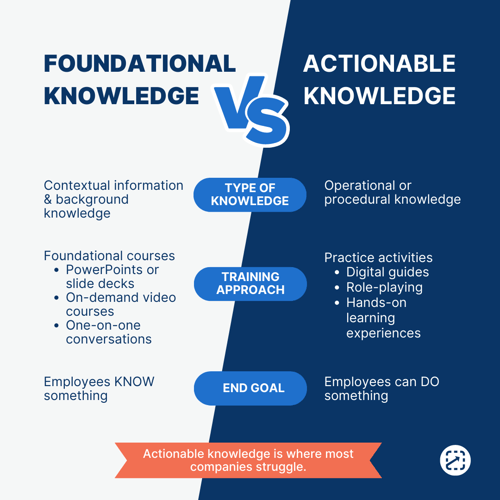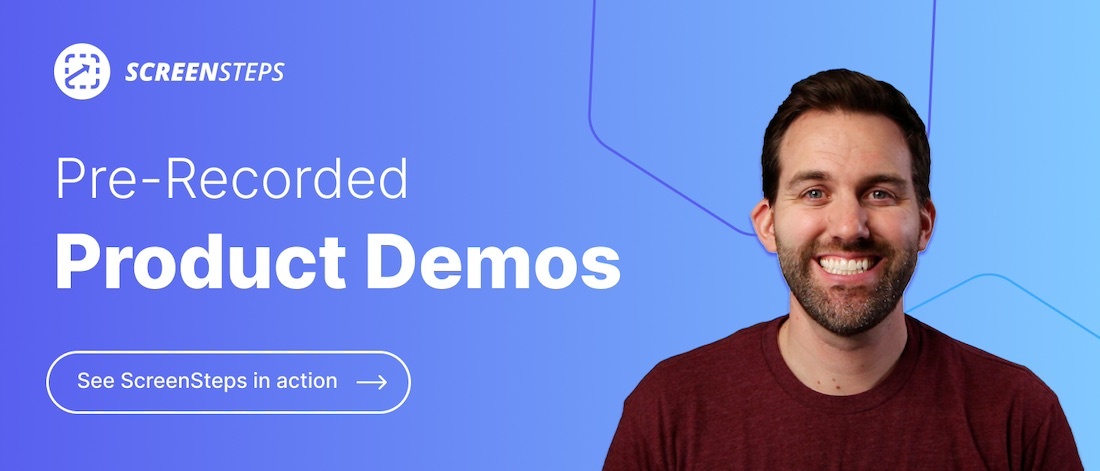Why an LMS Won’t Solve Your Onboarding Problem
ARTICLE SUMMARY:
- An LMS helps new hires KNOW information, but it doesn’t help them DO something.
- Most companies want an LMS to help them shorten training and help new hires reach proficiency faster — but an LMS doesn’t solve for those problems.
- You need a knowledge ops solution — technology + a framework — to improve your new hire onboarding program.
- ScreenSteps uses its knowledge ops platform + the Find & Follow Framework to help fill the role of a knowledge base and elements of an LMS.
You’re looking for a learning management system (LMS) to supplement your employee training program.
Most likely, you’re hoping that this will both help improve the new hire onboarding experience as well as improve employee performance.
Unfortunately, an LMS isn’t a “one software fixes all” solution.
Working as a knowledge transfer coach for ScreenSteps — a knowledge ops solution — I’ve worked with many businesses on building their employee training strategies. And, while I think LMS software is a great tool, it isn’t the only tool you need if you want to prepare your new hires for their jobs.
Here’s why an LMS won’t solve your onboarding problems on its own and what solution I recommend to make training better.
The reasons you may want an LMS
Why do you want a learning management system (LMS)?
An LMS is undoubtedly a great tool for delivering information. It helps with onboarding in that it provides a place to share self-service courses. And many LMS services provide off-the-shelf courses for universal business, like cybersecurity.
Often, companies get an LMS hoping that it will solve these challenges:
- Shorten time in onboarding or training session
- Help new hires reach proficiency faster (work independently)
- Help new hires leave training and be able to DO their jobs
- Prevent new hires from quitting during onboarding
- Reduce stress during the onboarding process
While an LMS is a great training and onboarding tool, it doesn’t solve these problems.
Why an LMS won’t solve those challenges (4 reasons)
As mentioned above, an LMS is a great tool for delivering information. The software will play a part in a good new hire training strategy, but it’s not the end-all to training solutions.
An LMS cannot guarantee that it will effectively transfer knowledge to employees in a way that helps businesses resolve the challenges listed in the section above. Here are four reasons why an LMS won’t solve those problems.
4 reasons an LMS won't solve your problems
1. It relies on memorization
When employees are learning something brand new, the expectation is that they will remember everything they are taught during training.
But we know that is not possible. Employees are often overwhelmed by the amount of information being thrown at them.
Trainers get a false sense of how much an employee has learned because employees are asked to pass quizzes. Most of the time, the questions in a quiz are easy to guess or they allow for multiple retakes. So employees do what they need to in order to pass the quizzes.
Then when the new hires finish onboarding and start their jobs, they can’t actually apply that knowledge to their job.
If your purpose of using an LMS is to try and increase a human’s capacity to memorize information, you are always going to be disappointed.
The bottom line is people can't memorize very much in a short amount of time. So even if you gamify it or make it fun with your LMS features, you're still running into the gravity problem where they can't remember it.
2. It rewards completion — not learning
Trainers have two main objectives when developing courses in an LMS:
- Did the employee enjoy it?
- Did the employee complete it (which involves passing all the quizzes)?
Those are the only two metrics that trainers are held accountable for. If enough employees came out of training saying they hated it, or completion rates were only 50%, then the trainer’s job would be on the line.
So what does the LMS focus on? Making training fun and driving completion.
But simply completing a course does not guarantee that employees have learned anything that can be applied during their job.
While an LMS course can help your new hires learn important principles and can help them achieve competency, when you take the wrong approach, an LMS course is simply a checkbox and is a waste of time.
3. It focuses on the wrong kind of knowledge
The role of an LMS is to transfer background information so that employees can understand the context of their job. That is what we call foundational knowledge. It is the background information of what they need to know.
Foundational knowledge is necessary for employees to develop competency in their roles.
However, trainers often make the mistake of using an LMS to try and transfer actionable knowledge. They’ll often include step-by-step videos expecting learners to memorize dozens of clicks, movements, or decisions.
Actionable knowledge is best transferred by doing realistic activities and scenarios while referencing digital guides, job aids, and procedures that can be easily accessed in a knowledge base.
If employees finish a course in an LMS, you should expect them to have a good foundational understanding of a topic. But you shouldn’t expect them to be able to perform tasks from memory.
4. It is passive
Watching several videos and passing an assessment doesn’t require the learner to go through the difficult work of applying what they’re learning to realistic situations.
It’s not that an LMS is bad. We actually think an LMS serves an important function in delivering foundational knowledge to employees. It’s just not a complete solution on its own because it doesn’t require any activities where learners are in the hot seat having to apply their knowledge.
Your LMS is solving an information delivery problem when you have a knowledge transfer problem.
Note: An LMS is not bad
It’s one piece of the puzzle and you need a more complete approach to solve those training problems listed above.
You may try one of the solutions we recommend below and still include an LMS. That’s great … as long as it is only one part of your onboarding strategy and technology stack.
How do you solve the onboarding problems?
So if an LMS in an incomplete approach to solving these onboarding issues, what is the other part?
First, you need to recognize that the root cause of your problems is you don’t have a knowledge transfer strategy.
When you are focused on what people need to know, you have a training and learning plan. If you want to focus on what you need people to do, you need a knowledge transfer strategy. Learn more about the difference between training/learning and knowledge transfer here.
One of the most effective knowledge transfer strategy approaches is knowledge operations (knowledge ops).
What are knowledge operations?
Knowledge operations in business is a collection of technologies and habits that allow employees to work without needing assistance from supervisors or subject matter experts (SMEs).
It is a strategy that helps you manage all the knowledge in your business. This includes how it is recorded AND how it is distributed.
Knowledge ops help you focus on what you need new hires to DO — not just what you need them to know. It’s an action-based approach to training your new hires.
New hires don’t need to memorize everything — they need to be familiar so that they can recognize situations. Then you need digital guides that employees can reference to prompt them on what to do.
Need help creating digital guides? Download this free digital guide template packet for Google Docs and Microsoft Word.
Knowledge ops solution: A real solution to your new hire onboarding problems
How do you implement knowledge ops as your knowledge transfer strategy? You do it with a knowledge ops solution.
A knowledge ops solution is a combination of software and frameworks that help prepare your new hires so that they can feel more confident on the job.
Software for knowledge ops
For the software side, you need knowledge management software. You can use a knowledge base to manage your digital guide and employee support resources. However, the best software for a knowledge ops strategy is a knowledge ops platform.
A knowledge ops platform has all the same features as a knowledge base plus courses. These courses are not as advanced as an LMS course in that they don’t have gamification and quizzes. But they do allow you to share self-service courses in the form of videos or text.
Frameworks for knowledge ops
ScreenSteps developed the Find & Follow Framework specifically to help companies transfer knowledge more efficiently. It is structured to help you onboard your employees in 30 days or less.
The framework helps you plan and prepare your resources, train your employees, and provide continued support throughout their careers.
With Find & Follow, training is broken down into foundational courses and practice activities. Most of the training is spent on role-playing to ensure new hires get plenty of hands-on experience before training is complete.
You can learn more about the Find & Follow Framework with this free new hire training playbook or free 30-minute course.
Don’t just buy software — get a solution that enhances your new hire onboarding program
Yes, software will help you improve your onboarding experience — but you can’t rely on software to make your training better. You need a full training solution.
ScreenSteps is a knowledge ops solution. By combining our knowledge ops platform and Find & Follow Framework, you can simplify employee onboarding.
Customers that have adopted Find & Follow have achieved up to 90% faster onboarding times, improved employee performance scores, and new hires are prepared to do their jobs right out of training.
Want to see what ScreenSteps could do for you?
Watch this 1.5-minute video that explains how ScreenSteps’ Courses feature works.
Check out the demo videos to see how other ScreenSteps features work.


.png)
